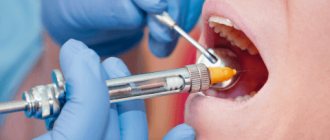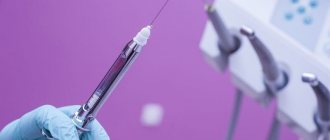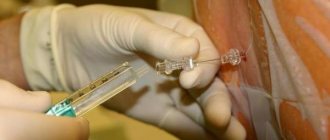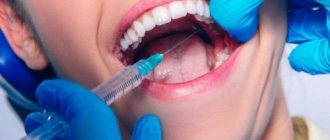Conduction anesthesia is considered the most effective method of pain relief in dental practice. The essence is to block nerve impulses that are directly responsible for pain syndromes in the brain.
After the administration of the anesthetic, the pain threshold is reduced to zero. This allows the necessary operation to be carried out smoothly. The advantages of this method are good tolerability and high efficiency. In addition, after the intervention, the pain syndrome continues to remain at a minimal level.
Use in dental practice
An anesthetic drug is injected into an area located a short distance from the site where surgery will be performed.
Conduction anesthesia can be performed in one of two ways:
- Central. The doctor determines the main trunks of the nerve endings for subsequent administration of the medicine into one of them.
- Peripheral. The anesthetic is injected into one of the branches of the main nerve of the stem system.
High-quality pain relief involves delivery of the solution to its destination. We are talking about a canal - a bone opening through which the nerve ending passes.
What is operated under local anesthesia in mammology?
The mammary glands are located superficially, they do not have muscles and large nerve trunks. Breast tissue is loosely located; in young women, glandular tissue predominates, which is replaced by fatty tissue with age. Therefore, for numerous manipulations and operations, local anesthesia can be used.
In mammology, anesthesia is used to perform invasive diagnostics, which include breast tissue biopsy. To do this, a local anesthetic is injected with a thin needle into the area of the intended puncture. After 10-15 minutes, the doctor can take breast tissue for examination without fear of causing pain to the patient.
Local infiltration anesthesia in mammology is used for small, minimally invasive operations. A woman can undergo puncture of a breast cyst after preliminary infiltration anesthesia. A similar approach can be used when removing small benign breast tumors.
In men, anesthesia is used during surgery for type 1 gynecomastia, when the size of the gland is still small. Infiltration of tissues increases hydrostatic pressure in them, thanks to which the doctor can easily separate pathological tissues from healthy ones.
Advantages
The preference for using this method in dentistry is due to the following advantages:
- the ability to block sensitivity over a large area of the jaw for the alternate removal of several units of the dentition, opening purulent abscesses;
- the need to use a small amount of the drug compared to alternative methods of pain relief.
It is worth highlighting a number of advantages associated with minimizing the likelihood of complications:
- reduced risk of developing neuropathic syndromes;
- there is no possibility of the solution penetrating into the vessels;
- improving the quality of blocking the sensitivity of nerve endings;
- high efficiency for operations of any complexity.
Indications
Conduction anesthesia is performed before the following therapeutic measures:
- simultaneous extraction of several units of the dentition located in one area of the oral cavity;
- removal of tooth roots with inflammatory processes;
- removal of pathological teeth (for example, those that have grown into the gums);
- implantology (used for painless implantation);
- surgical intervention on the lower molars (molars);
- treatment of inflammation in the maxillofacial region;
- elimination of inflammation on mucous membranes and soft tissues;
- treatment of complex carious cavities;
- with intolerance to general anesthesia.
Maxillary anesthesia
- Palatal method. Allows you to completely block sensitivity in the palate area, making any manipulation absolutely painless. The action of the anesthetic spreads simultaneously to the alveolar process.
- Tuberal. This technique is used for operations or extraction of molars.
- Infraorbital. Suitable for treating canines, premolars, and incisors.
- Incisive. Anesthesia is injected into the mucosal area located between the incisors and canines.
Mandibular anesthesia
- Mental way. It is carried out for the treatment of premolars, incisors, and canines.
- Mandibular. It involves blocking all units of the dentition on the side where the drug is administered.
- Torusal. Involves the introduction of a solution into the roller of the movable jaw, called the torus. Allows you to block pain symptoms in the area of premolars, as well as molars.
There is another Bershe Dubov method. It is used for maxillofacial surgical interventions. Anesthesia applies to all elements on one side. The needle can be inserted intraorally or extraorally.
Restrictions
Before choosing a pain relief method, it is important to exclude contraindications. These include:
- some operations performed on patients under 12 years of age;
- disturbance of the psycho-emotional state in a pronounced form;
- skin diseases in the area of intervention;
- allergic reactions to antiseptics;
- patients with congenital deaf-muteness;
- inability to establish contact with the patient.
Local anesthesia
Local anesthesia in a general sense is the anesthesia of a separate field in which surgical procedures are performed, while maintaining the patient's consciousness.
Local anesthesia allows you to numb the specific area where the intervention is planned. At the time of the manipulation, the patient is fully conscious, absolutely adequately assesses what is happening around him and has the ability to quickly respond to a changing situation and sensations. In fact, the use of local anesthesia in most cases is more than justified and is sufficient for even complex surgical operations.
For local administration of all types of anesthetics, special reusable syringes are used, which have a recess for inserting a carpule - this is a hermetically sealed ampoule with an anesthetic.
Painless administration of the drug using so-called carpule syringes is ensured by a very thin needle, which allows the drug to be administered slowly without damaging the tissue. All reusable syringes, like other reusable instruments, must undergo basic antiseptic treatment in disinfection solutions, sterilization using modern ultrasonic equipment and autoclaving (temperature treatment under pressure).
A carpule (or cartridge) is a transparent glass cylindrical container with a silicone piston at one end and a silicone stopper and metal cap at the other end. The design guarantees safety.
Types of local anesthesia
Application anesthesia
Application is widely used during simple operations with a short-term analgesic effect. For application (superficial, terminal) anesthesia, excellent penetrating and permeating the upper layers of the skin or oral mucosa are used, blocking receptors and peripheral nerve fibers, which provides an analgesic effect.
The drug in the form of a solution, gel, ointment, aerosol of high concentration is applied with a sterile cotton swab or fingers to the treated area, penetrates the soft tissue layer, reducing their sensitivity. The drug penetrates to a depth of 3 mm. Very often, this type of anesthesia precedes another type of anesthesia.
The effect is achieved in just a few minutes and lasts up to 25 minutes.
Infiltration anesthesia
Infiltration anesthesia consists of an injection that is injected around. In everyday life, this type of anesthesia is often called “freezing”.
This is the most commonly used method of pain relief, used to work on soft tissues in maxillofacial surgery, during operations on the alveolar process, during tooth extraction and treatment. Infiltration anesthesia can be performed with the introduction of an anesthetic sub- and inside the mucous membrane, supraperiosteally, into the periodontal fissure, as well as when administered intraosseously.
As a rule, the doctor decides on its use when treating the teeth of the upper jaw, since the alveolar process has a more porous structure, which provides a more effective result.
The action time is about 1 hour, enough to carry out manipulations above the average level of complexity - endodontic treatment, pulp removal, treatment of complex (deep) caries.
Conduction anesthesia
The purpose of general anesthesia during dental procedures is to block the nerve that transmits the pain signal. As a result of this, the effect of “disabling” an entire row or section of the jaw is achieved, and not just the diseased tooth.
This type is most often used when it is necessary to treat or remove several teeth located nearby at once (use on the lower jaw is most common).
Action time is from 1.5 to 2 hours. A widely used option is called conduction mandibular anesthesia. As mentioned earlier, this type makes it possible to effectively anesthetize the lower jaw and perform complex interventions in the area of molars.
Anesthesia for intraligamentous administration
Intraligmentary is also called intraperiodontal dental anesthesia. A special feature of this type is the application of greater pressure during the administration of the drug. Penetration into the intraosseous space is ensured by uniform distribution of the product in the periodontal space.
It begins to act almost instantly - after 15-45 seconds. Action time is from 20 minutes to half an hour.
Intraosseous anesthesia
The decision to use this type is made by the doctor in the case when, due to specific factors, the use of other types of anesthesia is impossible or ineffective.
Typically used in the treatment and removal of chewing teeth of the lower jaw (molars), operations on the alveolar process. Creating a hole in the bone tissue with the help of a bur in this case involves dissecting the mucous membrane, the needle enters the resulting hole, and anesthesia is applied to the spongy substance under noticeable pressure. The drug is effective even at relatively small doses, which can be considered an advantage when choosing this type of anesthetic.
Action time – from 1 hour.
Trunk anesthesia
This type involves influencing the branches of the trigeminal nerve at the very base of the skull. The use of this type is justified when the doctor plans versatile surgical manipulations in the maxillofacial apparatus while the anesthetic has an analgesic effect simultaneously on the upper and lower jaws.
The dentist will correctly select an effective and safe anesthetic drug, taking into account the planned treatment and the possible psycho-emotional stress of the patient.
Benefits of local anesthesia
- almost absolute blocking of any unpleasant sensations,
- safety, modern products do not have a toxic effect on your body,
- rapid excretion through the kidneys,
- unlike general anesthesia, they have virtually no side effects,
- the drug is selected based on the clinical picture, health conditions and age of the patient.
A logical question: are there any disadvantages to local anesthesia?
Local anesthesia is highly effective and shows virtually no disadvantages when used. Unlike drugs that were used previously, modern anesthetics are absolutely safe, have a minimum of contraindications, are easily eliminated from the body, do not harm the cardiovascular system, and do not have a destructive effect on the kidneys and liver. With professional administration, the patient will not feel any pain even during long surgical procedures.
Anesthesia safety is an extremely important aspect of treatment!
The constant increase in the range of drugs increases the level of responsibility of the administration of our center and doctors for a professionally oriented and pharmacologically sound choice of effective and safe anesthetic drugs, especially for patients at anesthetic risk.
In our dental center, the entire range of medicinal products undergoes strict control and is taken into account in the latest national system of digital product labeling “Honest Sign”.










